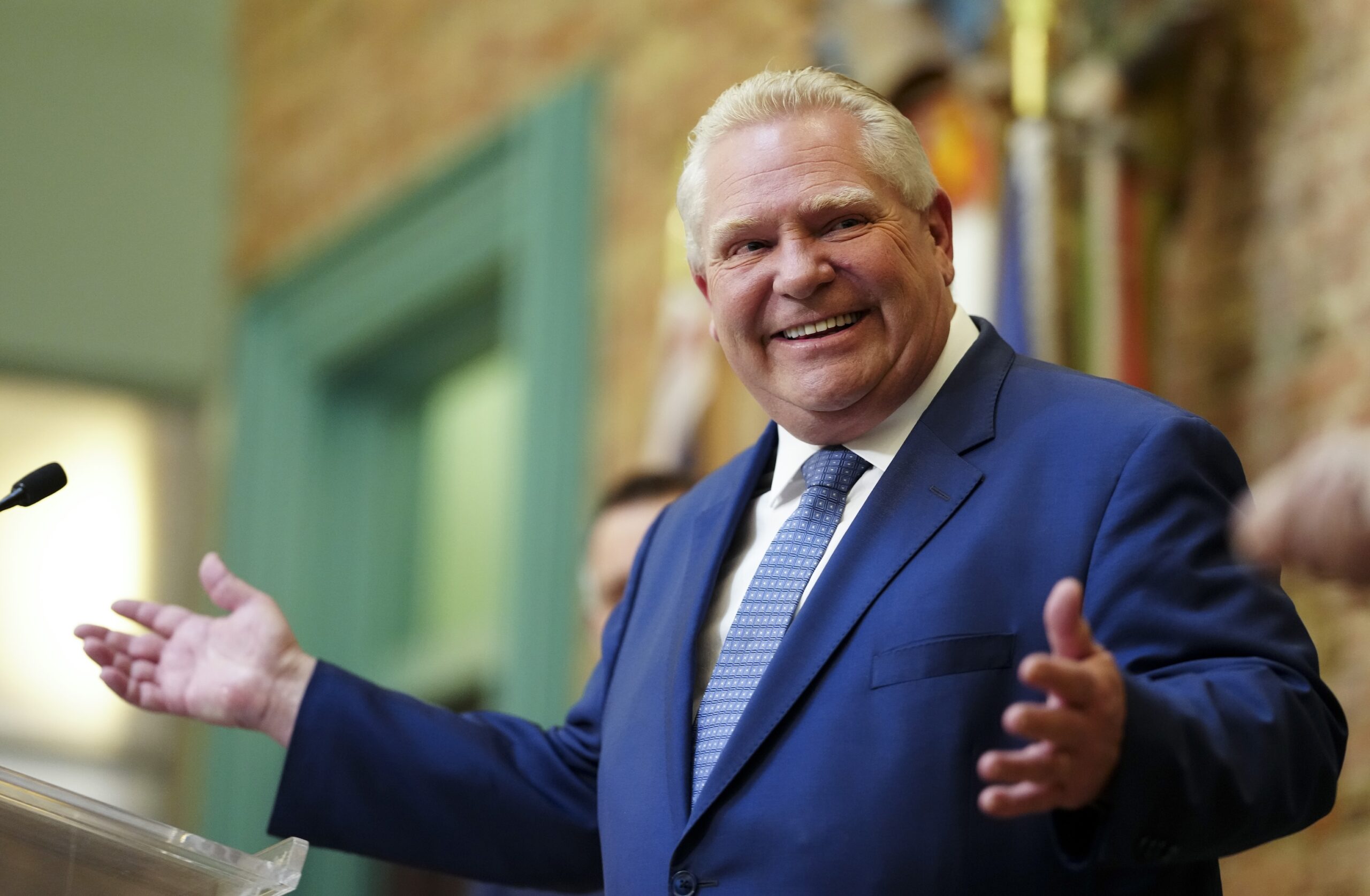Queen’s Park was abuzz with activity on Thursday, as the Ontario Legislative Assembly rose for the annual summer recess on June 6, after a period of pointed debate and legislative activity since February – and a swearing-in ceremony for the newly shuffled cabinet occurring later in the evening.
The motion to adjourn the legislature, tabled by Deputy Government House Leader Trevor Jones, came as an 11th hour surprise to the opposition and many in the press gallery. Not only was the House adjourned a few days earlier than initially scheduled, but members will also not return to the House until October 21 – six weeks after the originally agreed to return date of September 9, 2024.
While the premier and his government caucus members were adamant the work MPPs will do outside of the legislature will benefit Ontarians, the extended summer break in the sitting has only added more fuel to speculation of an early election in 2025 and, potentially, a legislative reset and new speech from the throne in the fall.
As outlined in Budget 2024, the provincial government finds itself in a complicated fiscal position, due to factors such as slower projected GDP and economic growth, considerable infrastructure spending, spending on health care and workforce development and the impacts of Bill 124, which imposed a one per cent wage increase cap on all public sector workers in 2019 before the Ontario Court of Appeal ruled the legislation as unconstitutional and forced the government to award more than $6 billion in backdated payments. As a result, the government faces a projected $9.8 billion deficit in the upcoming fiscal year, up from $3 billion in the 2023-24 fiscal year. The deficit is expected to decline to $4.6 billion in 2025-26 before an expected surplus of $500 million in 2026-27.
As MPPs go back to their constituencies for the summer, Premier Ford and the PC Party hold a comfortable lead over the opposition parties, according to aggregated public polling data compiled by 338Canada. The Ontario PCs currently stand at 39 per cent support, ahead of the Ontario Liberal Party at 28 per cent and Ontario NDP at 21 per cent.
However, the Ontario PCs continue to face pressures throughout the summer in housing, infrastructure and energy.

Cabinet shuffle
Late on Thursday, June 6, the Ford government announced it would be holding a swearing in ceremony for a new and expanded cabinet, after an afternoon of one-on-one meetings with the premier and his ministers. Premier Ford unveiled his cabinet ahead of the summer and upcoming fall season beginning in late October. The newly organized ministry now has 36 ministers, including the premier, and is the largest cabinet in Ontario’s history. In 2018, when Premier Ford first took office, the cabinet had 22 members.
The changes include some new faces, new names and swaps of major portfolios. The newest changes to the cabinet include:
- Stephen Lecce becomes Minister of Energy and Electrification, after spending five years as Education Minister.
- Todd Smith becomes Minister of Education, effectively swapping portfolios with Lecce.
- Stan Cho becomes the Minister of Tourism, Culture and Gaming, with responsibility for OLG.
- Todd McCarthy becomes Minister of Public and Business Service Delivery and Procurement, with responsibility for Supply Ontario.
- Rob Flack becomes Minister of Farming, Agriculture and Agribusiness.
- Mike Harris becomes Minister of Red Tape Reduction.
- Natalia Kusendova-Bashta becomes Minister of Long-Term Care.
- Neil Lumsden becomes Minister of Sport.
- Greg Rickford becomes Minister of Indigenous Affairs and First Nations Economic Reconciliation and remains Minister of Northern Development.
- Graydon Smith becomes Minister of Natural Resources.
- Lisa Thompson becomes Minister of Rural Affairs.
- Steve Clark becomes Government House Leader, almost one year after resigning as Minister of Housing as a result of the Greenbelt land swap scandal.
The most notable change to the premier’s front bench is the shuffle between Lecce and Todd Smith.
New faces to the cabinet include Kitchener-Conestoga MPP Mike Harris who becomes a full member of cabinet after serving as the premier’s parliamentary assistant, and Mississauga Centre MPP Natalia Kusendova-Bashta, who takes over as minister of long-term care after previously serving as the parliamentary assistant to the minister of seniors and accessibility. As well, Rob Flack makes the jump from associate housing minister to full minister of farming, agriculture and agribusiness.
Some ministries were given new names to add greater emphasis on the backend of the government’s agenda such as adding electrification to the name of the energy portfolio. The newly named Ministry of Tourism, Culture and Gaming also puts a spotlight on gaming and giving it equal standing to the other sectors.
More shuffling at Queen’s Park – in all parties – is expected over the coming months, as more MPPs look to make the jump to federal politics ahead of the 2025 federal election.
Government priorities
Housing and affordability
Ontario’s Bill 185: Cutting Red Tape to Build More Homes Act, 2024, was introduced to address the province’s housing crisis by rolling back some controversial changes made in Bill 23: the More Homes Build Faster Act, originally passed into law in November, 2022. Bill 185 allows municipalities to raise development charges without the previously mandated five-year phase-in period.
The change has been much awaited by municipalities, as it provides a significant new revenue stream. On the other hand, the development industry argued that it will increase the cost of building homes, making the housing affordability crisis even worse. The bill also exempts universities from certain requirements of Bill 23 to facilitate the construction of student residences, aiming to “alleviate student housing shortages.”
As Ontario residents continue to feel the limited housing supply and the rising cost of living, Ottawa and Queen’s Park did reach a deal ensuring $357 million in federal funds will flow to the province to build affordable housing. Under this bilateral housing agreement, Queen’s Park has submitted a revised ‘action plan’ detailing the affordable housing projects that are receiving provincial funding. The new 2022-25 plan forecasts at least 8,644 more affordable housing units will be built by March 31, 2025.
While these agreements move the province closer to its goal of building 1.5 million new homes by 2031, it still remains far off the pace needed to reach that goal in the next seven years. Budget 2023 projected fewer than 80,000 housing starts in 2024, but revised statistics from the province show the number of expected housings starts in the province in 2024 to be nearly 90,000. Under the provinces projections in Budget 2024, those annual housing starts are scheduled to increase to 95,800 by 2027. Unfortunately, in order to reach the 1.5 million new homes target, Ontario needs to see 125,000 new homes built in 2024 and increasing to 175,000 each year by 2031 due to missed targets in 2021 and 2022. A lofty challenge for any government.
Infrastructure
In May of this year, Bill 162: the Get It Done Act, 2024 received Royal Assent with the objective to accelerate the construction of transit, housing and infrastructure projects to support Ontario’s growing population. It notably amends other acts within Ontario for matters related to expropriation in order to facilitate the construction of new infrastructure, specifically the Highway 413 expansion and the new Bradford bypass.
The Ontario government is moving ahead to get shovels in the ground on Highway 413 after having reached an agreement with Ottawa to bypass the federal environmental assessment requirements for the project, and instead use the existing assessment completed by the provincial government. With cooperation between both levels of government, the province is currently undertaking fieldwork, including borehole drilling and engineering, to evaluate soil composition and bedrock depth.
The Bradford bypass is also getting closer to reality as the Ontario government has awarded design contracts and preliminary work on bridges and the widening of County Road 4.
The Ontario Line in Toronto has also made progress over the last year, and the western portion of the Eglinton Crosstown LRT is making some progress toward construction. The long-awaited LRT project remains delayed beyond planned completion, despite being scheduled to open in 2022. The government refuses to give a firm timeline for its opening, or a total cost to complete the work.
Energy + electric vehicles
With the recent investments in electric vehicle, battery assembly and manufacturing, and the expanded mandate of the energy and electrification ministry, the government is positioning Ontario to be a global leader in energy and EV manufacturing. In February, the former Energy Minister, Todd Smith, tabled Bill 165 Keeping Energy Costs Down Act, 2024 that would seek to keep energy costs down for families based on the Ontario Energy Board’s decision to increase costs in December 2023. The bill became law in May.
Further, Ontario launched the Grid Innovation fund to invest $9.5 million to support projects to make the province’s electricity system more efficient – focusing on heating and cooling.
Ontario is attempting to establish itself as the global leader in electric vehicle production through an end-to-end supply chain process. This past spring Premier Ford and Prime Minister Justin Trudeau made two announcements to expand the electric vehicle supply chain in Ontario – Honda and Asahi Kasei both are building their own manufacturing facilities in Ontario. Honda’s investments aim to build an electric vehicle assembly plant and a battery manufacturing plant in Alliston, and CAM/pCAM processing plant and separator plant in Port Colborne. Asahi Kasei is investing $1.6 billion to build an EV battery separator plant in Port Colborne, Ontario.
Political context
Ontario NDP
Opposition NDP Leader Marit Stiles held no punches on Thursday when asked about the Premier’s decision to take an extended summer break, in light of her party’s calls for the Information and Privacy Commissioner of Ontario to investigate and report on the Ford government’s handling of documents related to the Greenbelt scandal.
From the lobby of the legislature, and outside the protections of parliamentary privilege, Stiles told assembled media, “This is a government that doesn’t want to get any work done and doesn’t want to be held to account because, guess what, this is a corrupt government, this is a corrupt premier.” She added, “If he wants to sue me, go for it. Come on out, we’ll see what information we can get.” The RCMP has opened a criminal investigation into the government’s land swap deals in the Greenbelt with developers.
As has been a focus of the Ontario NDP for much of the current session, the opposition’s critic for seniors, Lise Vaugeois, is calling upon Premier Ford to amend the Residential Tenancies Act to prevent the eviction of Ontario retirement home residents.
Ford announced an additional 100,000 MRI and CT scans a year to help with the wait times for diagnostic tests. NDP Leader Stiles responded saying that the Ford government is now using the private sector to add capacity and it is one step closer to creating a private health care system.
For its efforts in bringing allegations of corruption and backroom deals against the Ford government to light, the Stiles and the Ontario NDP face their own internal challenges to expand their support, having fallen behind the third place Liberals in public polls since Bonnie Crombie took control of the Ontario Liberal Party. Stiles and the NDP are struggling to shake off association with the federal NDP, which remains deeply unpopular outside of Ontario’s major urban centres, particularly so in the vote-rich suburban heartland of the Golden Horseshoe, just outside the GTA. The NDP is also struggling to keep the support of the younger, post-secondary student wing of the party in the wake of ongoing campus encampments and protests against Israel’s ongoing invasion of Gaza and the party’s decision to expel Hamilton Centre MPP Sarah Jama from caucus.
Ontario Liberal Party
Premier Doug Ford’s push to get wine and beer into convenience stores ahead of schedule will cost the Ontario taxpayers at least $225 million, but there is evidence from the Ontario Liberals that it could add up to be more. The Ontario Liberal Party claims the costs will add up to be $1 billion in direct payouts to the Beer Store, grocery chains, and convenience store owners, as well as foregone revenue for the LCBO. The Liberals are asking both Ontario’s auditor general and the Financial Accountability Office to investigate the full cost of the deal.
Further, Ontario Liberal Leader Bonnie Crombie, still without a seat in the legislature after declining to run in either of this month’s by-elections, is formally requesting an update from the RCMP on the ongoing investigation into the Ford government’s $8.3 billion Greenbelt scandal. Crombie’s request came after new documents were obtained through a freedom of information request by the Ontario NDPs reveal there were undisclosed meetings between Ford’s staff and a developer.
Election speculation
On May 28, media reported that Premier Ford would not be calling a snap election in the immediate future, after days of rampant speculation and suspicious non-answers from the premier. In spite of his declarations to the contrary, many Queen’s Park watchers still believe the premier could call an election more than a year early in the spring or summer of 2025, in order to get ahead of the next federal election, scheduled for October of next year.
The rationale for this speculation is that an early provincial election could insulate Premier Ford and his Ontario Progressive Conservative Party from a potential change of government at the federal level, any austerity measures in the federal budget in the spring of 2026 and the findings of the RCMP investigation into the Greenbelt land swap scandal and the potential fallout.
Insights in this piece contributed by Shakir Chambers and Nastassia Varela.








